- Joined
- Feb 26, 2009
- Messages
- 277,087
- Reaction score
- 8
If you are an experienced angler or even someone fairly new to the sport ‘The Method’ will be known to you if only in name. It’s one of the best and most effective fish-catching innovations anyone can use without the need for lots of dangly bits.
In principle, ‘The Method’ and, therefore, the method-feeder is no different to the way we used to mould a ball of ground-bait around a running lead in order to draw-in the fish but, like so many ‘garden shed’ ideas, it has been perfected for purpose in both design and materials. Now we can click a mouse and have a perfect product in our hands within 24-48 hours…and they last forever!
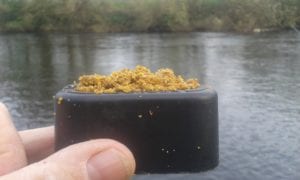
Over-fill the mould to allow for compression
Using, say…the Preston Innovations model, is a bit (just a bit!) like decorating in that it’s all about preparation; the actual deployment of the feeder and the mould could hardly be simpler but the feed itself must be properly mixed where a ground-bait is to be moulded, or correctly prepared if particles such as pellets are to be used in similar fashion. The added bonus to this wondrous ruse is that your baited hook is right in there, in the mould, along with all the freebies – and all the easier to cast as a result! And down on the lake or river-bed, why wouldn’t your quarry confidently sip-in your hook-bait when all those around it are perfectly safe to eat?
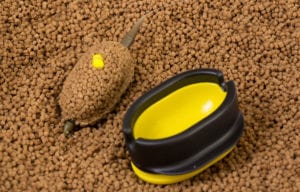
Moulding pellets is just as easy as moulding a fine ground-bait mix, you just need to make them sticky and sufficiently malleable to retain the mould-shape and to hold together on casting. I used to achieve this, in my swim, with one or two of those ‘garden shed’ utensils I frequently refer to, but a purpose-made pellet-wetter is SO much easier and very much more reliable…it’s simply a case of filling (or part-filling) the zip-around tray with pellets and immersing it in the water-filled bowl for 2-3 minutes. Remove, shake-off excess water and let them stand for 5 minutes to soften. They’re then ready to use in the mould – along with your hook-bait of course! (A spoonful of Horlicks or powdered egg albumen – if you can get it – is a good binder)
You just fill the mould with the damp, sticky pellets and firmly press-in the feeder frame. Then press- out the perfectly formed module using the sprung ejector in the base. The nicely-loaded, aerodynamic feeder will withstand a long, tangle-free cast and I usually use it semi– fixed by way of a tail-rubber which fits around the top half of the hook-length swivel while the feeder frame fits snugly over the tapered end.
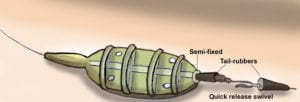
Hair rigs aren’t essential; directly-baited hooks worked for years enough and will continue to do so where the offering is suitable e.g. corn, maggot, soft pellet and, yes, bread-flake, but for today’s super-effective boilies and drilled pellets they’re the only way. Make your own or, for sheer convenience and complete confidence, consider using one of the professionally-tied hair-rigs with just the right sized loop and a strong, super-sharp hook. Used in conjunction with a quick-change swivel on your main line, hook lengths (hair rigs) can be changed in seconds if a different hook size is required.
Loading the feeder frame with a ground-bait mixture is every bit as easy, the water content and the resultant consistency being largely intuitive. Ready-made, feeder-dedicated mixes, however, often give guidelines on how to achieve the correct texture – and there’s plenty of choice.
There’s a wide variety of feeder brands, designs and weights to choose from, many of which can be found both in the tackle shop and on-line. Not all work on the Preston principle, some – like the Korda Bait-Up – are stand-alone frames around which you manually mould as big a ball of bait as you wish.
I regularly fish the Wye where it is both wide and fast. The majority of fish – barbel, chub, dace – come from the furthest quarter. I cast upstream at 1-2 o’clock and leave the bale arm open for a couple of seconds after the feeder has splashed-down and hit bottom. This allows a large bow in the line to form and this is far more resistant to drag than a straight line which is, initially, tight to the feeder; make this mistake and within seconds, everything will be swept downstream until you’re fishing not far short of the near margin!
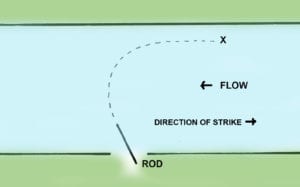 Correct way to tackle a fast-flowing river
Correct way to tackle a fast-flowing river
With my rig settled upstream or, at least, opposite at 12 o’clock, my rod is aligned downstream at around 10 o’clock. The strike is made upstream – however odd this may seem at first; but when you imagine striking downstream it’s easy to see how ineffective this would be. Get it right and you could be in for specimens like this beauty…
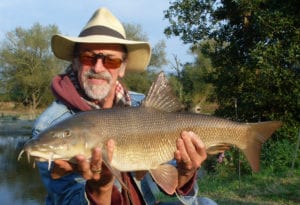
His Wyeness Geoffrey Maynard of Hay shows us the magnificent result of fishing as described above.
…or this cracker!

Good ol’ ‘lunny’ accounted for this double-figure fish, the first of four doubles I took in 2014.
Cliff Hatton.
Source Article...
In principle, ‘The Method’ and, therefore, the method-feeder is no different to the way we used to mould a ball of ground-bait around a running lead in order to draw-in the fish but, like so many ‘garden shed’ ideas, it has been perfected for purpose in both design and materials. Now we can click a mouse and have a perfect product in our hands within 24-48 hours…and they last forever!

Over-fill the mould to allow for compression
Using, say…the Preston Innovations model, is a bit (just a bit!) like decorating in that it’s all about preparation; the actual deployment of the feeder and the mould could hardly be simpler but the feed itself must be properly mixed where a ground-bait is to be moulded, or correctly prepared if particles such as pellets are to be used in similar fashion. The added bonus to this wondrous ruse is that your baited hook is right in there, in the mould, along with all the freebies – and all the easier to cast as a result! And down on the lake or river-bed, why wouldn’t your quarry confidently sip-in your hook-bait when all those around it are perfectly safe to eat?

Moulding pellets is just as easy as moulding a fine ground-bait mix, you just need to make them sticky and sufficiently malleable to retain the mould-shape and to hold together on casting. I used to achieve this, in my swim, with one or two of those ‘garden shed’ utensils I frequently refer to, but a purpose-made pellet-wetter is SO much easier and very much more reliable…it’s simply a case of filling (or part-filling) the zip-around tray with pellets and immersing it in the water-filled bowl for 2-3 minutes. Remove, shake-off excess water and let them stand for 5 minutes to soften. They’re then ready to use in the mould – along with your hook-bait of course! (A spoonful of Horlicks or powdered egg albumen – if you can get it – is a good binder)
You just fill the mould with the damp, sticky pellets and firmly press-in the feeder frame. Then press- out the perfectly formed module using the sprung ejector in the base. The nicely-loaded, aerodynamic feeder will withstand a long, tangle-free cast and I usually use it semi– fixed by way of a tail-rubber which fits around the top half of the hook-length swivel while the feeder frame fits snugly over the tapered end.

Hair rigs aren’t essential; directly-baited hooks worked for years enough and will continue to do so where the offering is suitable e.g. corn, maggot, soft pellet and, yes, bread-flake, but for today’s super-effective boilies and drilled pellets they’re the only way. Make your own or, for sheer convenience and complete confidence, consider using one of the professionally-tied hair-rigs with just the right sized loop and a strong, super-sharp hook. Used in conjunction with a quick-change swivel on your main line, hook lengths (hair rigs) can be changed in seconds if a different hook size is required.
Loading the feeder frame with a ground-bait mixture is every bit as easy, the water content and the resultant consistency being largely intuitive. Ready-made, feeder-dedicated mixes, however, often give guidelines on how to achieve the correct texture – and there’s plenty of choice.
There’s a wide variety of feeder brands, designs and weights to choose from, many of which can be found both in the tackle shop and on-line. Not all work on the Preston principle, some – like the Korda Bait-Up – are stand-alone frames around which you manually mould as big a ball of bait as you wish.
I regularly fish the Wye where it is both wide and fast. The majority of fish – barbel, chub, dace – come from the furthest quarter. I cast upstream at 1-2 o’clock and leave the bale arm open for a couple of seconds after the feeder has splashed-down and hit bottom. This allows a large bow in the line to form and this is far more resistant to drag than a straight line which is, initially, tight to the feeder; make this mistake and within seconds, everything will be swept downstream until you’re fishing not far short of the near margin!
 Correct way to tackle a fast-flowing river
Correct way to tackle a fast-flowing riverWith my rig settled upstream or, at least, opposite at 12 o’clock, my rod is aligned downstream at around 10 o’clock. The strike is made upstream – however odd this may seem at first; but when you imagine striking downstream it’s easy to see how ineffective this would be. Get it right and you could be in for specimens like this beauty…

His Wyeness Geoffrey Maynard of Hay shows us the magnificent result of fishing as described above.
…or this cracker!

Good ol’ ‘lunny’ accounted for this double-figure fish, the first of four doubles I took in 2014.
Cliff Hatton.
Source Article...
Last edited by a moderator:
